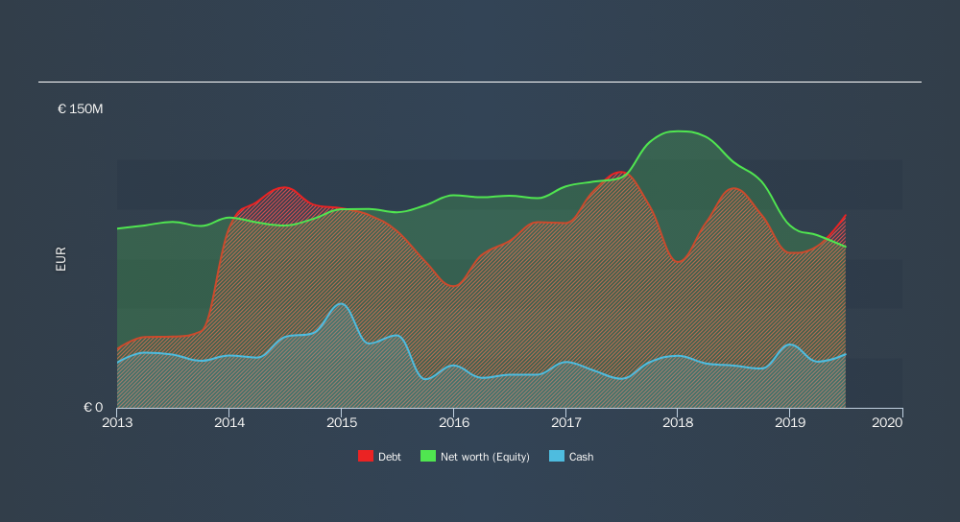These 4 Measures Indicate That MAX Automation (ETR:MXHN) Is Using Debt In A Risky Way

Legendary fund manager Li Lu (who Charlie Munger backed) once said, 'The biggest investment risk is not the volatility of prices, but whether you will suffer a permanent loss of capital. So it seems the smart money knows that debt - which is usually involved in bankruptcies - is a very important factor, when you assess how risky a company is. Importantly, MAX Automation SE (ETR:MXHN) does carry debt. But is this debt a concern to shareholders?
Why Does Debt Bring Risk?
Debt and other liabilities become risky for a business when it cannot easily fulfill those obligations, either with free cash flow or by raising capital at an attractive price. Part and parcel of capitalism is the process of 'creative destruction' where failed businesses are mercilessly liquidated by their bankers. However, a more common (but still painful) scenario is that it has to raise new equity capital at a low price, thus permanently diluting shareholders. Of course, plenty of companies use debt to fund growth, without any negative consequences. When we think about a company's use of debt, we first look at cash and debt together.
See our latest analysis for MAX Automation
What Is MAX Automation's Debt?
The image below, which you can click on for greater detail, shows that MAX Automation had debt of €96.8m at the end of June 2019, a reduction from €121.5m over a year. However, it also had €26.9m in cash, and so its net debt is €69.9m.
A Look At MAX Automation's Liabilities
The latest balance sheet data shows that MAX Automation had liabilities of €155.4m due within a year, and liabilities of €119.0m falling due after that. Offsetting these obligations, it had cash of €26.9m as well as receivables valued at €52.0m due within 12 months. So it has liabilities totalling €195.5m more than its cash and near-term receivables, combined.
Given this deficit is actually higher than the company's market capitalization of €141.4m, we think shareholders really should watch MAX Automation's debt levels, like a parent watching their child ride a bike for the first time. Hypothetically, extremely heavy dilution would be required if the company were forced to pay down its liabilities by raising capital at the current share price.
We measure a company's debt load relative to its earnings power by looking at its net debt divided by its earnings before interest, tax, depreciation, and amortization (EBITDA) and by calculating how easily its earnings before interest and tax (EBIT) cover its interest expense (interest cover). The advantage of this approach is that we take into account both the absolute quantum of debt (with net debt to EBITDA) and the actual interest expenses associated with that debt (with its interest cover ratio).
MAX Automation has a debt to EBITDA ratio of 3.6 and its EBIT covered its interest expense 4.2 times. This suggests that while the debt levels are significant, we'd stop short of calling them problematic. Worse, MAX Automation's EBIT was down 23% over the last year. If earnings keep going like that over the long term, it has a snowball's chance in hell of paying off that debt. The balance sheet is clearly the area to focus on when you are analysing debt. But it is future earnings, more than anything, that will determine MAX Automation's ability to maintain a healthy balance sheet going forward. So if you want to see what the professionals think, you might find this free report on analyst profit forecasts to be interesting.
Finally, a company can only pay off debt with cold hard cash, not accounting profits. So the logical step is to look at the proportion of that EBIT that is matched by actual free cash flow. In the last three years, MAX Automation's free cash flow amounted to 22% of its EBIT, less than we'd expect. That weak cash conversion makes it more difficult to handle indebtedness.
Our View
On the face of it, MAX Automation's level of total liabilities left us tentative about the stock, and its EBIT growth rate was no more enticing than the one empty restaurant on the busiest night of the year. And furthermore, its conversion of EBIT to free cash flow also fails to instill confidence. After considering the datapoints discussed, we think MAX Automation has too much debt. While some investors love that sort of risky play, it's certainly not our cup of tea. Over time, share prices tend to follow earnings per share, so if you're interested in MAX Automation, you may well want to click here to check an interactive graph of its earnings per share history.
When all is said and done, sometimes its easier to focus on companies that don't even need debt. Readers can access a list of growth stocks with zero net debt 100% free, right now.
We aim to bring you long-term focused research analysis driven by fundamental data. Note that our analysis may not factor in the latest price-sensitive company announcements or qualitative material.
If you spot an error that warrants correction, please contact the editor at editorial-team@simplywallst.com. This article by Simply Wall St is general in nature. It does not constitute a recommendation to buy or sell any stock, and does not take account of your objectives, or your financial situation. Simply Wall St has no position in the stocks mentioned. Thank you for reading.

